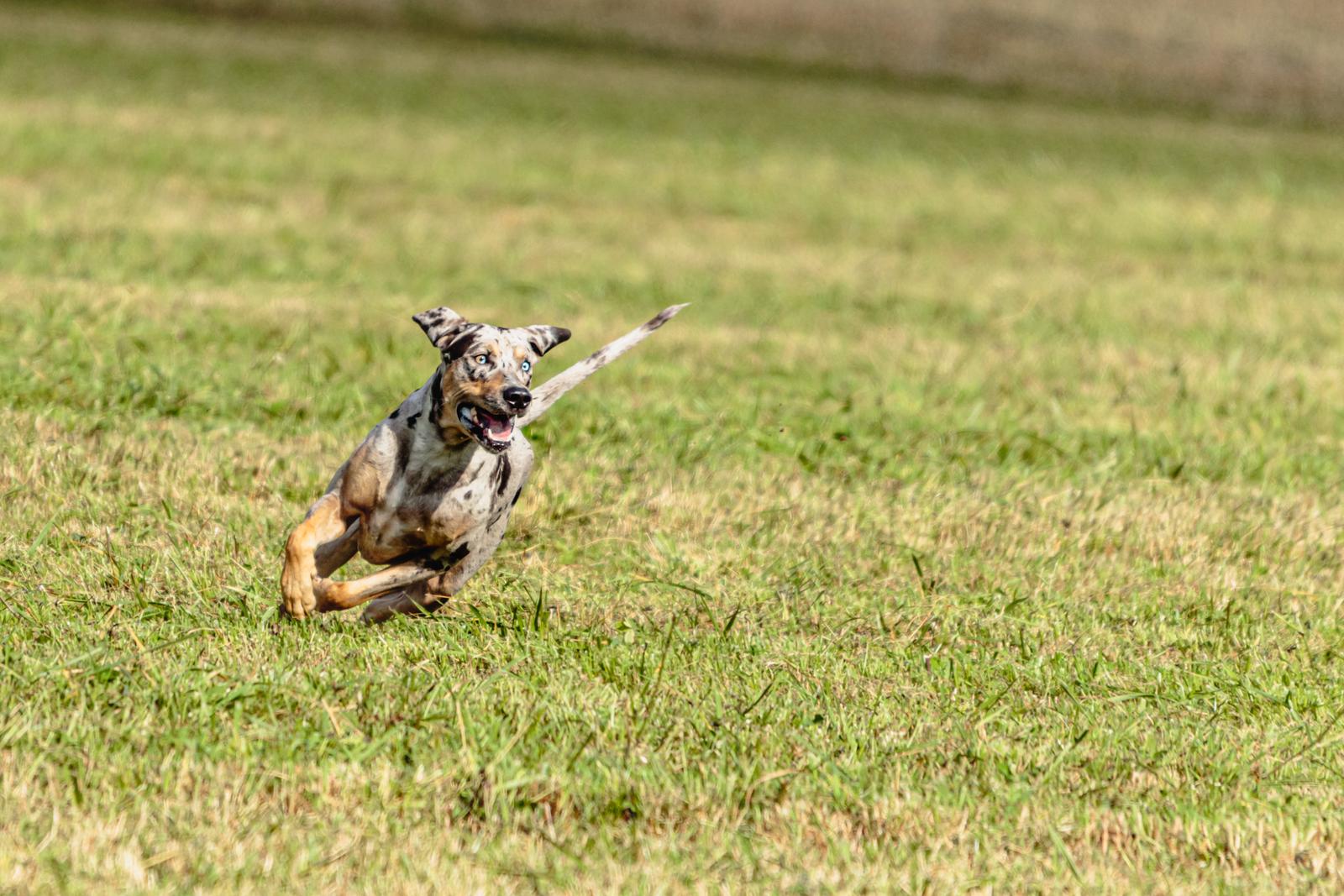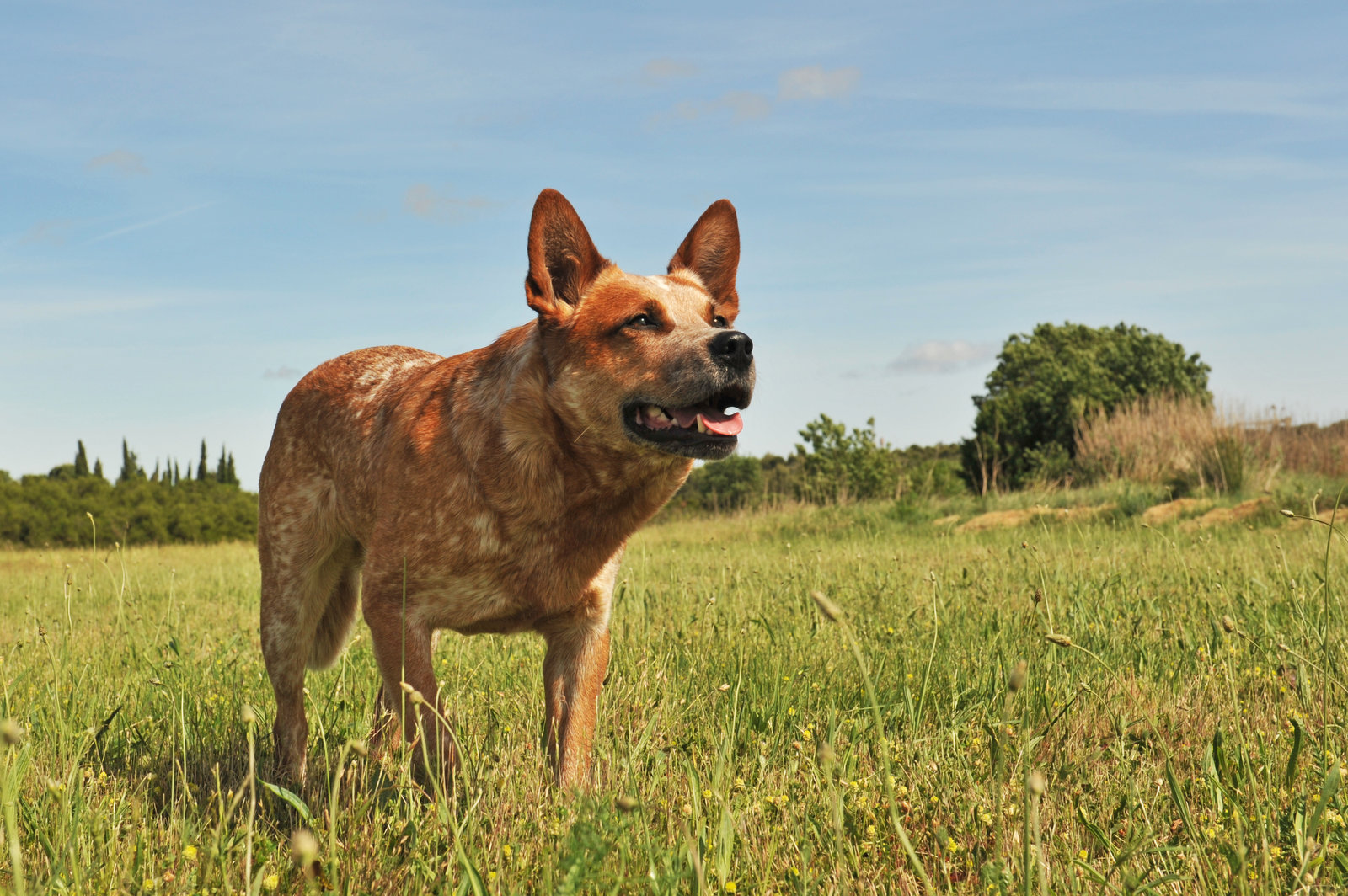The Catahoula Leopard Dog and Australian Cattle Dog are distinct breeds with unique histories and traits. Both are working dogs known for their intelligence and herding abilities. Let’s explore the similarities and differences between these two dog breeds.
If you’re still on the market to buy a Catahoula Leopard Dog or Australian Cattle Dog, PuppySpot currently offers a $300 discount using the code PUPPY300, just click the banner below!
Physical Attributes
Catahoula Leopard Dogs and Australian Cattle Dogs have distinct physical features. These traits affect their appearance, health, and suitability for different environments.
Size and Weight Comparison
- Catahoula Leopard Dogs are generally larger than Australian Cattle Dogs. Male Catahoulas typically stand 22-26 inches tall and weigh 65-90 pounds. Females are slightly smaller at 20-24 inches and 50-65 pounds.
- Australian Cattle Dogs are more compact. Males usually measure 18-20 inches in height and weigh 35-50 pounds. Females are 17-19 inches tall and weigh 30-45 pounds.
- These size differences impact their space needs and exercise requirements. Catahoulas may need more room, while Australian Cattle Dogs can adapt to smaller living spaces.
Coat and Color Variations
Catahoula Leopard Dogs have short, smooth coats that come in various colors and patterns. Their most distinctive feature is the merle coat, which creates unique spotted or mottled patterns.
Common Catahoula colors include:
- Blue merle
- Red merle
- Brindle
- Chocolate
- White with patches
Australian Cattle Dogs have dense, weather-resistant double coats. They come in two main color varieties:
- Blue speckled or mottled
- Red speckled
Both breeds shed moderately and require regular brushing to maintain their coats.
Common Health Issues
Both breeds are generally healthy, but they can be prone to certain conditions.
Catahoula Leopard Dogs may experience:
- Deafness (especially in merle-coated dogs)
- Hip dysplasia
- Eye problems
Australian Cattle Dogs can be susceptible to:
- Progressive retinal atrophy
- Hip and elbow dysplasia
- Deafness
Both breeds may develop joint diseases as they age. Regular vet check-ups and genetic testing can help prevent or manage these health issues.

Temperament and Personality
Catahoula Leopard Dogs and Australian Cattle Dogs have distinct personalities. Both breeds are energetic and intelligent, but they differ in key ways that affect their behavior and interactions.
Understanding Their Personality
- Catahoula Leopard Dogs are independent and can be stubborn at times. They have a strong will and may try to test boundaries. These dogs are known for their assertive nature and confidence.
- Australian Cattle Dogs, also called Blue Heelers, are highly intelligent and focused. They excel at problem-solving and thrive on mental stimulation. These dogs are loyal and form strong bonds with their owners.
- Both breeds are energetic and need plenty of exercise. Without proper outlets, they may become bored and destructive. Regular physical activity and mental challenges are essential for their well-being.
Socialization and Behavior
- Early socialization is crucial for both breeds. Catahoula Leopard Dogs benefit greatly from socialization efforts, which help make their training more effective. They can be wary of strangers and may not get along well with other dogs if not properly socialized.
- Australian Cattle Dogs are generally more social but can be reserved with strangers. They tend to be good with children when raised with them. These dogs often form strong bonds with one person in the family.
- Both breeds have a high prey drive and may chase small animals. Proper training and socialization can help manage this instinct. Supervision is important when introducing them to new people or animals.
Territorial and Protective Instincts
- Catahoula Leopard Dogs are known for their protective nature. They make excellent watchdogs and will alert their owners to potential threats. These dogs can be territorial and may be aggressive towards unfamiliar people or animals if not properly trained.
- Australian Cattle Dogs also have strong protective instincts. They are alert and make good watchdogs. These dogs may try to herd family members, especially children, due to their strong herding instincts.
- Both breeds require consistent training to manage their protective tendencies. Early socialization helps prevent excessive aggression or fear-based behaviors. Proper guidance ensures they become well-adjusted adult dogs.
Training and Intelligence
Catahoula Leopard Dogs and Australian Cattle Dogs are both intelligent working breeds. They excel in different areas when it comes to training and mental abilities.
Trainability and Learning Ability
- Catahoula Leopard Dogs can be challenging to train. They have an independent nature that requires patience and consistency from their owners. Short training sessions work best to keep their interest.
- Australian Cattle Dogs are highly trainable. They pick up new commands quickly and enjoy learning. These dogs thrive on mental stimulation and tasks.
- Both breeds benefit from early socialization. This helps them become well-adjusted adult dogs. Positive reinforcement techniques work well for training both Catahoulas and Cattle Dogs.
Intelligence and Working Capabilities
- Catahoula Leopard Dogs show their smarts through problem-solving skills. They excel at tasks that let them think independently. These dogs make great watchdogs and hunters.
- Australian Cattle Dogs rank among the brightest dog breeds. Their intelligence shines in herding and obedience work. They can learn complex commands and routines with ease.
- Both breeds need jobs to stay happy. Without proper mental and physical exercise, they may become bored and destructive. Puzzle toys and agility training can help keep their minds sharp.
Care Requirements
Catahoula Leopard Dogs and Australian Cattle Dogs have specific care needs. These active breeds require attention to exercise, grooming, and diet to stay healthy and happy.
Exercise Needs
- Both breeds need lots of exercise. Catahoula Leopard Dogs and Australian Cattle Dogs are high-energy dogs that thrive on physical activity.
- They do best with 1-2 hours of exercise daily. This can include walks, runs, or playtime in a fenced yard.
- Mental stimulation is key too. Puzzle toys and training sessions help keep their minds sharp.
- Without enough exercise, these dogs may become bored and destructive. Regular activity prevents obesity and keeps them fit.
Grooming and Maintenance
- These breeds have different grooming needs. Catahoula Leopard Dogs have short, smooth coats that are easy to care for.
- Australian Cattle Dogs have a double coat that sheds more. They need weekly brushing to remove loose fur.
- Both breeds should have their nails trimmed regularly. Teeth brushing is important for dental health.
- Bathe these dogs only when needed to avoid drying out their skin. Check their ears weekly for signs of infection.
Dietary Considerations
- A balanced diet is crucial for both breeds. High-quality dog food suited to their age, size, and activity level is best.
- Portion control is important to prevent obesity. Adult dogs usually need two meals a day.
- Fresh water should always be available. Some owners add supplements for joint health, especially for active dogs.
- Both breeds can be prone to hip dysplasia, so maintaining a healthy weight is key. Consult a vet for specific dietary advice.
- Regular vet check-ups and vaccinations are essential for both breeds. This helps catch any health issues early.
Living Conditions
Catahoula Leopard Dogs and Australian Cattle Dogs have different needs when it comes to living spaces. Their adaptability and energy levels play a big role in how well they fit into various home environments.
Adapting to Home Environment
- Catahoula Leopard Dogs need lots of space. They do best in homes with large yards. These dogs can live in shelters outdoors but also do well inside if given enough exercise. They stand 20-26 inches tall and have high energy.
- Australian Cattle Dogs are more flexible. They can adapt to smaller spaces like apartments if given enough activity. These dogs are 17-20 inches tall. Both breeds have long lifespans of 10-14 years.
- Neither breed does well with long alone times. They need regular exercise and mental stimulation to stay happy.
Suitability for Families
- Catahoula Leopard Dogs can be good family pets with proper training. They are protective and loyal. These dogs need firm, consistent handling due to their independent nature.
- Australian Cattle Dogs also make great family pets. They are smart and eager to please. These dogs form strong bonds with their families. Both breeds have high exercise needs.
- For active families, either dog can be a good fit. Australian Cattle Dogs may be better for first-time owners. Catahoulas need more experienced handlers.
- Both dogs need early socialization. This helps them get along with kids and other pets. Neither breed is ideal for families who can’t provide lots of exercise and attention.

Health and Lifespan
Both Catahoula Leopard Dogs and Australian Cattle Dogs are generally healthy breeds. They have similar lifespans but face different health challenges. Proper care and regular vet check-ups can help prevent many common issues.
Lifespan Expectancy
Catahoula Leopard Dogs typically live 12-14 years, while Australian Cattle Dogs have a slightly longer lifespan of 13-15 years. Both breeds can live longer with good care and nutrition.
Factors affecting lifespan include:
- Diet quality
- Exercise routine
- Regular vet care
- Genetic predispositions
To help these dogs live long, healthy lives, owners should focus on providing a balanced diet, plenty of exercise, and routine health screenings.
Preventing Common Health Issues
Both breeds can face certain health problems, but many can be prevented or managed with proper care.
Catahoula Leopard Dogs may be prone to:
- Hip dysplasia
- Eye problems like progressive retinal atrophy
- Deafness
Australian Cattle Dogs might experience:
- Hip and elbow dysplasia
- Progressive retinal atrophy
- Deafness (especially in blue-coated dogs)
Regular vet check-ups are crucial for early detection of these issues. Owners should watch for signs of discomfort or changes in behavior. Proper diet and exercise can help prevent joint problems. For both breeds, keeping ears clean can reduce the risk of infections. Regular eye exams can catch vision problems early. Genetic testing before breeding can help reduce the risk of hereditary conditions in puppies.



